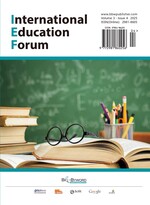Abstract
This paper studies the path and strategy of the integrated education of innovation and entrepreneurship education and ideological and political education in colleges and universities. Given the problems such as lack of integration opportunity, lack of pertinity and imperfect system guarantee, this paper puts forward the integration strategy with professional accomplishment as the guide, mass creation projects as the carrier and system optimization as the starting point, builds the education model of “value leading — ability training — quality improvement”, and creates the practice platform of “project guidance — school-enterprise collaboration — teachers and students co-creation.” The research shows that this model can effectively improve students’ innovative spirit, practical ability, and social responsibility and provide theoretical and practical support for college education reform and high-quality personnel training.
References
Zheng JS, 2024, The Organic Integration of College Ideological and Political Education and College Students’ Innovation and Entrepreneurship Education. School Party Building and Ideological Education, 2024(7): 88–90.
Chen LH, 2023, Research on the Integration of Ideological and Political Education and Innovation and Entrepreneurship Education for College Students. Jilin Education, 2023(23): 44–46.
Wang J, 2023, Research on the two-way Integration of Innovation and Entrepreneurship Education and Ideological and Political Education of College Students — A Case Study of Xi’an Translation University. Chengcai, 2023(3): 46–47.
Yu Y, 2022, Research on the Integration of College Students’ Innovation and Entrepreneurship Education and College Ideological and Political Education. Road to Success, 2022(13): 49–51.
Guo XL, Zhang LP, 2022, Research on the Value and Path of Integrated Development of Ideological and Political Education and Employment and Entrepreneurship Education of College Students. Journal of Mudanjiang College of Education, 2022(1): 91–93.
Li CX, Yu ZS, 2021, On the Organic Integration of Ideological and Political Education and Innovation and Entrepreneurship Education of College Students. Theoretical Research and Practice of Innovation and Entrepreneurship, 4(23): 84–86.
He X, 2021, Research on the Path of Integration of Ideological and Political Education and Innovation and Entrepreneurship Education for College Students. Theoretical Research and Practice of Innovation and Entrepreneurship, 4(21): 103–105.
Yan CL, 2021, Feasibility of Integration of Ideological and Political Education and Innovation and Entrepreneurship Education of College Students. Journal of Hubei Open Vocational College, 34(13): 31–32.
Wang Y, 2021, On the Organic integration of College Ideological and Political Education and College Students’ Innovation and Entrepreneurship Education. Comparative Research on Cultural Innovation, 5(8): 20–22.
Chen B, 2020, A Brief Analysis on the Feasibility of the Integration of Ideological and Political Education and College Students’ Innovation and Entrepreneurship Education. Science and Education Literature Review (Last ten-day issue), 2020(31): 40–41.
Feng W, 2022, Discussion on the Construction Plan of Multimedia Teaching Resource Library of Innovation and Entrepreneurship Courses in Colleges and Universities. Television Technology, 46(1): 11–14.
Li QY, 2023, Exploration of Mass Innovation and Entrepreneurship Education for College Students in the Context of General Education. Educational Technology and Innovation, 5(3): 110–114.
Liu B, Liu BH, 2021, Reflection and Model Construction of Innovation and Entrepreneurship Education in Undergraduate Universities. Journal of Hubei Open Vocational College, 34(23): 7–8.
Lu Y, 2021, Research on the Integration of Innovation Practice and Ideological and Political Education in Colleges and Universities from the Perspective of Sanquan Education. Jilin Education, 2021(20): 111–113.
Wang H, 2024, Research on the Path of Dual Innovation Integration of Ideology, Politics and Curriculum in Higher Vocational Courses. Journal of Jianghan Petroleum Workers University, 37(2): 88–90.
